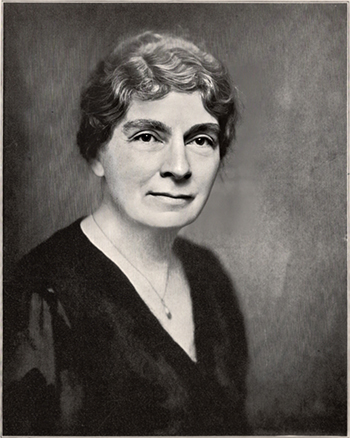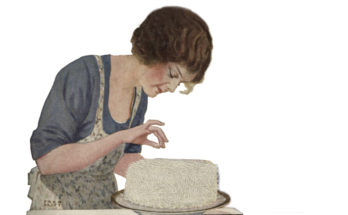
Visit Reddit for cooking booklets by Lily Wallace.
Lily Haxworth Wallace is the author of my favorite mid-century go-to cookbook, New American Cook Book which I’ve referred to since my early 20s. Her recipes are simple with very few ingredients–great for beginners. She wrote cookbooks and booklets published between 1908 and 1950.
Lily Haxworth, born in Yorkshire England, 1872, was a Gold Medalist graduate of the National Training School of Cookery, Buckingham Palace Road, London. Upon graduation circa 1894, Lily taught public school girls in London at Battersea Polytechnic Institute. Each student’s enrollment lasted one half-year and in Lily’s own words they were taught, “to cook and clean and prepare real meals that were served in the Institute’s dining room where we of the faculty did the carving. It was there I learned to carve.” That helped her to write the 1941 book, “Carving the Easy Way.” She added, “We taught those English girls to care for their rooms and how to make aprons and caps and underwear and finally each girl drafted and made a dress for herself, and was ready for a home and a husband. We even taught her how to starch and iron white shirts so she could do up her husband shirts, for we expected most of them to marry.” Before moving to the US, she toured England lecturing on food and cooking, but I don’t know who she represented. Mysteries abound in her early resume.
In 1897 she moved to the US, and her first job, still as a food lecturer, allowed her to travel to New England, the South, and the Midwest. After the American tour, she vacationed in Canada and met her future husband, George C. Wallace, another English ex-patriot. In June, 1900 she boarded at 107 West Mohawk St., in Buffalo, New York. Guess who lived in the same boarding house? Her husband-to-be, George C. Wallace, a flour and cereal salesman of Brooklyn. Buffalo was a shipping and rail center, and the city had grain mills, including the precursor to Washburn-Crosby co. and General Mills—maybe this was where George’s company was headquartered, and Lily’s too? Mystery.
Lily Haxworth became an American citizen in 1902. She was vouched for by a Manhattan advertising agent who knew her for as long as she had been in America. Did this advertising agent meet her in England during her food tour, and hire her to go to America? Possibly. His name was Charles H. Post.
Before Buffalo and before their marriage, Lily Haxworth’s husband-to-be, George C. Wallace lived in Brooklyn at 442 Classon Ave. When they married in September 1904 Lily kept her maiden name “Haxworth” as her middle name “for it ties me up with the past.” She lived in the States for over half her life but always thought of herself as a Yorkshire woman. From 1905 to 1908 Lily and George lived at 264 St James Place, Brooklyn. He was a salesperson. The census listed her as “at home” yet she didn’t stop working after marriage. Early in the marriage she wrote articles for at least one magazine, Style & American Dressmaker, wrote a cookbook for Rumford Baking Powder, and another cookbook, The Modern Cook Book and Household Recipes. She was a popular speaker at Laurel Park’s Chautauqua, and gave lecture demonstrations at the Pure Food Shows in New York, the Food Expositions in Washington, DC and in New Haven, Connecticut. She was introduced at the expo as “World’s foremost authority on Cookery. Gold Medalist and graduate of the National School of Cookery, London…Demonstrating Lectures by Gas and Electricity each afternoon during the Exposition.” Early career she was also an instructor at the Household Arts Department at the Ballard School Ballard School for practical nursing, YMCA in New York City.
Lily Wallace was tirelessly employed within the years, even during the Great Depression, writing books, booklets, magazine articles, newspaper articles, photographing, lecturing, and hosting radio shows and booths at food fairs. She was food editor at Woman’s World Magazine from about 1924 to 1950, and had leadership roles in Domestic Science and Homemaking organizations.
There was a “L. H. Wallace” in Brooklyn from 1917 to 1920 who had a phone with a different Brooklyn address each year, yet in the same neighborhood as her later most permanent address on Pacific Street. There was no record of her husband George having a phone. Early on, Lily bought land in Edgecomb, Maine deeded just in her name. In 1922 she built a summer cottage there, and used it as her summer retreat from Brooklyn.
In 1920 her husband George switched from selling grain and cereal to being a coffee salesperson, and Lily was listed as a product secretary. Now they lived at 1436 Pacific St., Brooklyn. The phone was listed under “Mrs. L. H. Wallace.” This is the last we heard of Lily’s husband living with her. A newspaper woman interviewed Lily at her home in 1927 and I got the impression that her husband didn’t live there as the two bedrooms were for “visiting family.“
George C. Wallace, husband of Lily, was committed to the psychiatric Central Islip State Hospital some time between 1920 and 1930. This could have been related to the Great Depression that struck in 1929, but we don’t know how long he had been committed before his death there in 1931.
By 1927 on a floor below Lily’s Pacific Street apartment lived Henry Wellington Croney, born the same month and year as Lily, and his wife Margaret, both English from Barbados, they probably all shared similar accents, and they were all in the food business. Henry was described as a short, medium build, white, light blue eyes, dark brown hair, grocer. Their daughter Dorothy Evelyn Croney was born in 1903 in New York. Dorothy seems to have become the daughter that Lily never had.
During a 1927 interview, Lily was enthusiastic and chatty as she gave a newspaper reporter a tour of the apartment at 1436 Pacific St. Brooklyn. With the natural light from being on the top floor, Lily said she was able to photograph foods, table settings, and models in the dining room. So, not only was Lily a lecturer and author, but also a photographer for her writings! The reporter took special interest in the kitchen pantry where Lily had all her shelves lowered to 6″ high to see more inventory at a glance. Lily’s study was in a room beyond the kitchen range and cooking pots where there was “a crowded desk, a chair with a comfortable cushion, a filing cabinet, and a typewriting desk for her secretary.” Lily mentioned the study was where the real work was done–they made up recipes, drafted magazine articles, cared for a large correspondence, and thought a bit about the health of the world. Lily introduced Dorothy to the reporter as “my secretary.” In the 1930 census neighbor Dorothy Croney’s occupation was listed as “Stenographer, Home Economics.”
On June 13, 1932, Miss Dorothy Croney became Mrs. Edwin Crozier, marrying a man whom she stayed with until death. I’m not sure if Dorothy continued to work for Lily Wallace, but the friendship lasted for 25 years as Dorothy had been made executor and inherited Lily’s real property, other items going to Lily’s nephew in Exeter, England.
In 1944 Lily Wallace’s book, Seafood Cookery, had a forward written by the Duchess of Windsor, American wife of the Duke of Windsor, best known as being the abdicated English King Edward. At this moment he was at the end of his governor’s term in the Bahamas. After seeing the British TV fictionalized series, The Queen, a different image came to mind when hearing “Duchess of Windsor.” Either way, it made me wonder as to Lily’s social connections when she visited England, which she did over the years. But perhaps Lily and the Duchess met as part of Lily’s professional life.


